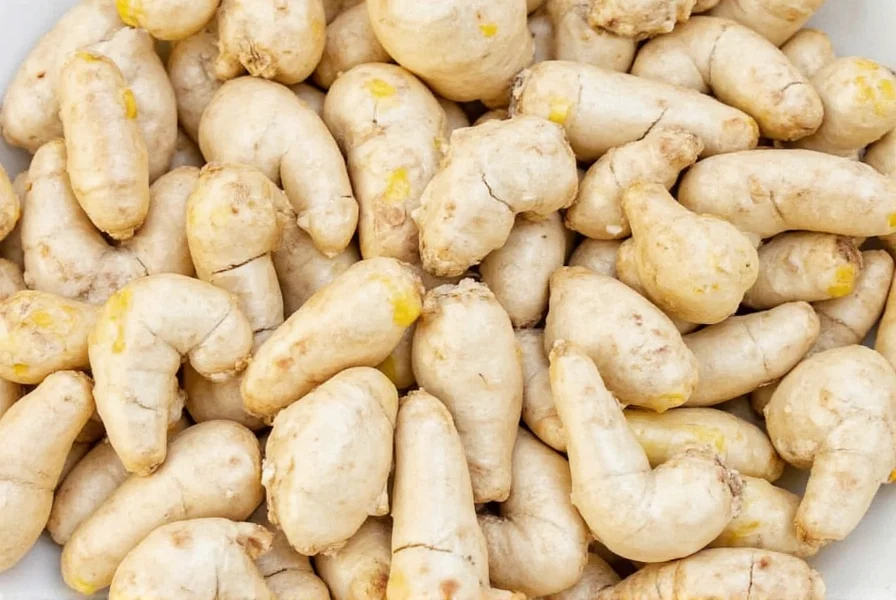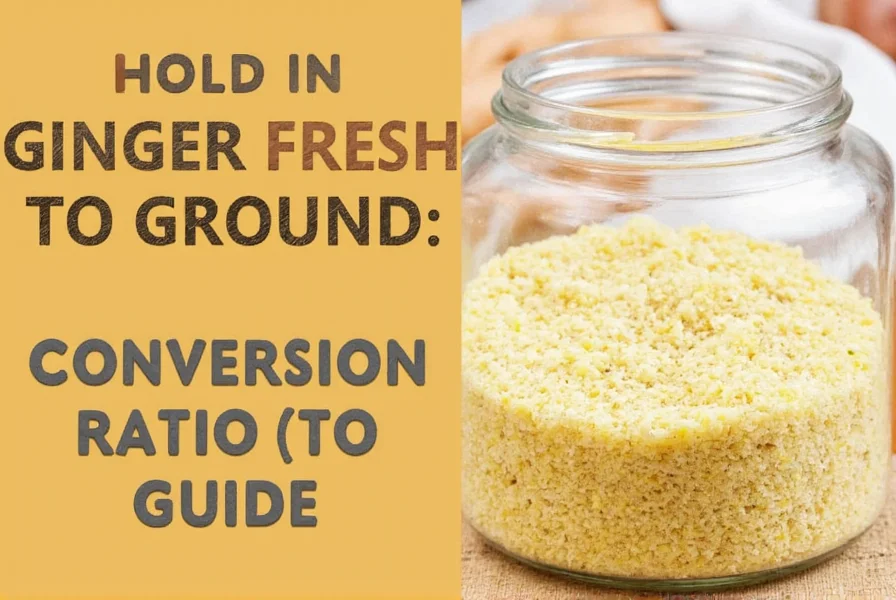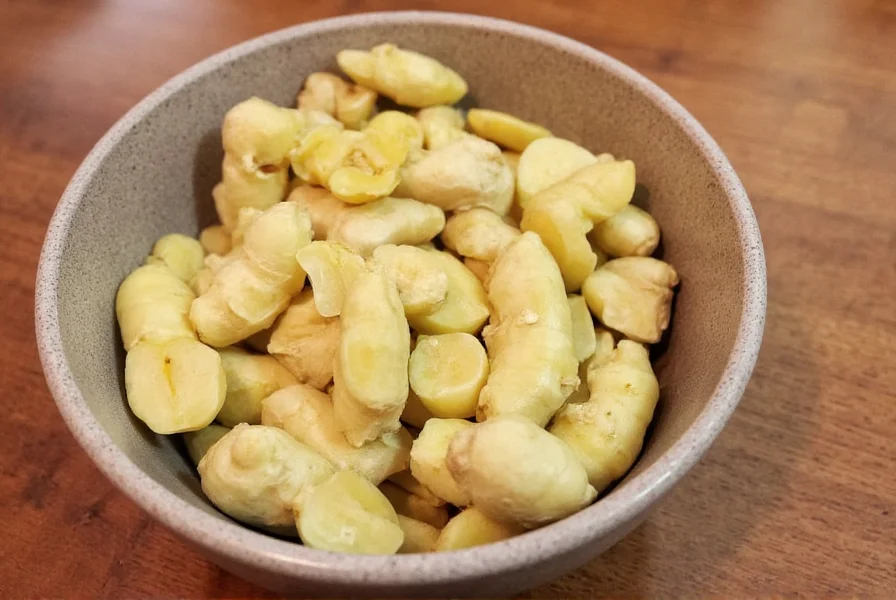When converting fresh ginger to ground ginger, the standard ratio is approximately 6:1. This means 6 tablespoons of freshly grated ginger equals about 1 tablespoon of ground ginger. Fresh ginger contains roughly 80% water, which evaporates during the drying process, concentrating the flavor compounds and resulting in this significant volume reduction. For precise recipe substitutions, 1 inch of fresh ginger (about 15 grams) yields approximately 1/4 teaspoon of ground ginger.
Understanding Fresh Ginger to Ground Ginger Conversion
Converting fresh ginger to ground form is a practical kitchen skill that helps when recipes call for one form but you only have the other available. Whether you're preserving a ginger harvest or adapting a recipe, understanding the proper conversion ratio ensures your dishes maintain the intended flavor profile without becoming overpowering or bland.
Key Differences Between Fresh and Ground Ginger
Fresh ginger and ground ginger differ significantly in both chemical composition and culinary application. Fresh ginger contains gingerol, which provides that characteristic spicy bite, while ground ginger contains more zingerone and shogaol—compounds formed during the drying process that create a warmer, more mellow flavor.
These chemical transformations explain why you can't use equal measurements when substituting one for the other. The drying process concentrates certain compounds while diminishing others, altering both potency and flavor characteristics.
Precise Conversion Measurements
Accurate measurement conversion is essential for recipe success. Here's a detailed reference table for converting between fresh and ground ginger:
| Fresh Ginger | Equivalent Ground Ginger | Best For |
|---|---|---|
| 1 inch piece (15g) | ¼ teaspoon | Subtle flavor in sauces |
| 2 inches (30g) | ½ teaspoon | Marinades and dressings |
| 3 inches (45g) | ¾ teaspoon | Stir-fries and sautés |
| 1/4 cup grated | 1 teaspoon | Baking and spice blends |
| ½ cup grated | 2 teaspoons | Strongly flavored dishes |
| 1 cup grated | 1 tablespoon | Preserves and chutneys |
Step-by-Step Process for Making Ground Ginger
Creating your own ground ginger from fresh rhizomes preserves maximum flavor and avoids additives found in commercial products. Follow these steps for optimal results:
- Select quality ginger: Choose firm, smooth rhizomes with tight skin and no soft spots
- Peel and slice: Remove skin and cut into 1/8-inch thick slices for even drying
- Dry thoroughly: Air-dry for 3-5 days or use a food dehydrator at 135°F (57°C) for 8-12 hours
- Test dryness: Slices should snap cleanly when bent, not bend or flex
- Grind to powder: Use a spice grinder or mortar and pestle for finest texture
- Sift and store: Pass through a fine mesh sieve and store in an airtight container

Storage Methods for Homemade Ground Ginger
Proper storage maintains flavor potency and prevents moisture absorption. Store your homemade ground ginger in:
- Airtight glass containers away from light and heat
- Small quantities to minimize air exposure when opening
- The freezer for long-term storage (up to 2 years)
Label containers with the preparation date, as homemade ground ginger typically maintains peak flavor for 6-8 months at room temperature. For best results in recipes requiring intense ginger flavor, replace your supply every 4-6 months.
Recipe Substitution Guidelines
When substituting between fresh and ground ginger, consider both the recipe type and desired flavor profile:
- Baking: Ground ginger works better in baked goods due to its even distribution
- Savory dishes: Fresh ginger provides brighter, more complex flavor in stir-fries
- Marinades: Fresh ginger offers better texture penetration
- Preserves: Ground ginger blends more smoothly in jams and chutneys
For recipes calling for 1 tablespoon of fresh ginger, use 1/2 teaspoon ground ginger as a starting point, then adjust to taste. Remember that ground ginger's flavor develops more slowly but lasts longer in cooked dishes.
Common Conversion Mistakes to Avoid
Many home cooks make critical errors when converting between ginger forms:
- Using equal measurements without accounting for water content loss
- Grinding insufficiently dried ginger, resulting in clumping
- Storing homemade powder in plastic containers that absorb odors
- Using old ginger that has lost volatile flavor compounds
- Adding ground ginger too early in cooking, causing flavor degradation

Flavor Profile Considerations
The flavor transformation during drying significantly impacts culinary applications. Fresh ginger offers:
- Sharp, bright, citrusy notes
- Higher gingerol content (anti-inflammatory properties)
- More pronounced heat that dissipates quickly
Ground ginger provides:
- Warmer, more earthy flavor profile
- Higher shogaol content (more stable during cooking)
- Smoother heat that lingers longer
Understanding these differences helps you make informed decisions when converting between forms or substituting in recipes.
Practical Applications in Cooking
Chefs often prefer using fresh ginger when:
- Creating Asian-inspired dishes where bright ginger flavor is essential
- Preparing beverages like ginger tea or fresh cocktails
- Adding to raw preparations like ceviche or fresh salsas
Ground ginger shines when:
- Baking cookies, cakes, and other desserts
- Creating spice blends and rubs
- Thickening sauces where texture matters
For the most complex flavor profiles, consider using both forms in the same dish—fresh for immediate impact and ground for sustained flavor throughout cooking.
Can I substitute ground ginger for fresh in all recipes?
While substitution is possible, it's not always ideal. Ground ginger works well in baked goods and spice blends but lacks the bright, sharp notes of fresh ginger in stir-fries and raw preparations. For best results, adjust quantities using the 6:1 ratio and consider the dish's flavor requirements.
How long does homemade ground ginger last?
Properly stored in an airtight container away from light and heat, homemade ground ginger maintains peak flavor for 6-8 months at room temperature. For extended shelf life, store in the freezer where it can retain quality for up to 2 years.
Why does my homemade ground ginger clump together?
Clumping occurs when ginger isn't completely dry before grinding. The remaining moisture causes the powder to stick together. Ensure ginger slices snap cleanly when bent before grinding, and consider adding a few grains of uncooked rice to the container to absorb excess moisture.
Does ground ginger have the same health benefits as fresh ginger?
The health benefits differ slightly due to chemical transformations during drying. Fresh ginger contains more gingerol (anti-inflammatory), while ground ginger has higher shogaol content (more stable during cooking). Both forms offer significant health benefits, but fresh ginger generally provides more potent immediate effects.
What's the best way to dry ginger for grinding?
For optimal results, slice ginger into 1/8-inch pieces and use a food dehydrator at 135°F (57°C) for 8-12 hours. Air drying works but takes 3-5 days and risks uneven drying. Oven drying is possible at the lowest setting with the door slightly ajar, but requires careful monitoring to prevent cooking rather than drying.











 浙公网安备
33010002000092号
浙公网安备
33010002000092号 浙B2-20120091-4
浙B2-20120091-4